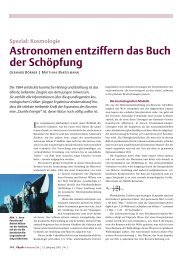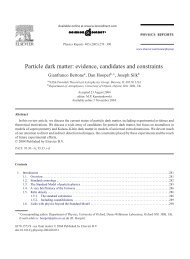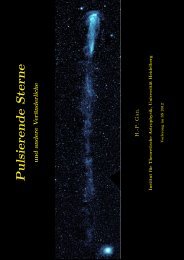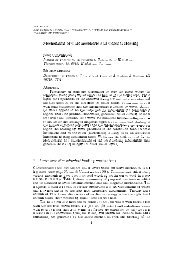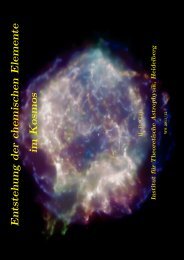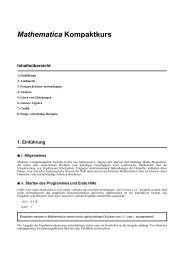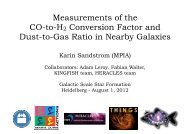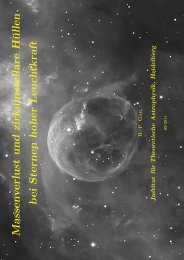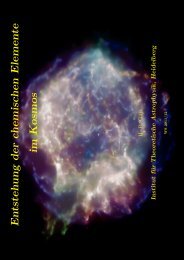Chapter 6 Riemann solvers I
Chapter 6 Riemann solvers I
Chapter 6 Riemann solvers I
You also want an ePaper? Increase the reach of your titles
YUMPU automatically turns print PDFs into web optimized ePapers that Google loves.
<strong>Chapter</strong> 6<br />
<strong>Riemann</strong> <strong>solvers</strong> I<br />
The numerical hydrodynamics algorithms we have devised in <strong>Chapter</strong> 5 were based on the idea<br />
of operator splitting between the advection and pressure force terms. The advection was done,<br />
for all conserved quantities, using the gas velocity, while the pressure force and work terms were<br />
treated as source terms. From <strong>Chapter</strong> 2 we know, however, that the characteristics of the Euler<br />
equations are not necessarily all equal to the gas velocity. We have seen that there exist an eigenvector<br />
which indeed has the gas velocity as eigenvectors, λ 0 = u, but there are two eigenvectors<br />
which have eigenvalues λ ± = u ± C s which belong to the forward and backward sound propagation.<br />
Mathematically speaking one should do the advection in these three eigenvectors, using<br />
their eigenvalues as advection velocity. The methods in <strong>Chapter</strong> 5 do not do this. By extracting<br />
the pressure terms out of the advection part and adding them as a source term, the advection part<br />
has been reduced essentially to Burger’s equation, and the propagation of sound waves is entirely<br />
driven by the addition of the source terms. Such methods therefore do not formally propagate the<br />
sound waves using advection, even though mathematically they should be. All the effort we have<br />
done in <strong>Chapter</strong>s 3 and 4 to create the best advection schemes possible will therefore have no<br />
effect on the propagation of sound waves. Once could say that for two out of three characteristics<br />
our ingeneous advection scheme is useless.<br />
<strong>Riemann</strong> <strong>solvers</strong> on the other hand keep the pressure terms within the to-be-advected system.<br />
There is no pressure source term in these equations. The mathematical character of the<br />
equations remains intact. Such <strong>solvers</strong> therefore propagate all the characteristics on equal footing.<br />
We shall see that <strong>Riemann</strong> <strong>solvers</strong> are based on the concept of the <strong>Riemann</strong> problem, so<br />
we will first dig into this concept. We will then cover the purest version of a <strong>Riemann</strong> solver:<br />
the Godunov solver, but we will then quickly turn our attention to linearized <strong>Riemann</strong> <strong>solvers</strong>,<br />
which are simpler to program and are conceptually more closely linked to the concept of characteristic<br />
transport. Perhaps the most powerful linear <strong>Riemann</strong> solver is the Roe solver which has<br />
the particular advantage that it recognizes shock waves and transports all characteristics nicely.<br />
As we shall see, <strong>Riemann</strong> <strong>solvers</strong> tend to have advantages, but also some disadvantages.<br />
One can therefore not say that they are always the method of choice. However, for problems<br />
involving shock waves, contact discontinuities and other high-resolution flow features, <strong>Riemann</strong><br />
<strong>solvers</strong> remain unparallelled in keeping these flow features sharp. For that reason they are becoming<br />
ever more popular.<br />
Many of the things covered in this chapter and in the next were inspired by the book of<br />
Randall LeVeque, “Finite Volume Methods for Hyperbolic Problems”.<br />
95
96<br />
6.1 Simple waves, integral curves and <strong>Riemann</strong> invariants<br />
Before we can delve into the concepts of <strong>Riemann</strong> problems and, lateron, <strong>Riemann</strong> <strong>solvers</strong>,<br />
we must first solidify our understanding of characteristic families, and the associated concepts<br />
of simple waves, integral curves and <strong>Riemann</strong> invariants. Since these concepts are important<br />
conceptually, but not of too great importance quantitatively, we shall remain brief here. Let us<br />
recall the following form of the Euler equations (cf. Eq. 6.1):<br />
⎛ ⎞ ⎛<br />
q 1<br />
∂ t<br />
⎝q 2<br />
⎠ + ⎝<br />
q 3<br />
0 1 0<br />
γ−3<br />
2 ρu2 (3 − γ)u (γ − 1)<br />
−{γe tot u +(γ − 1)u 3 } { γe tot + 3 2 (1 − γ)u2} γu<br />
where q 1 = ρ, q 2 = ρu and q 3 = ρe tot The eigenvalues are<br />
⎞ ⎛ ⎞<br />
q 1<br />
⎠ ∂ x<br />
⎝q 2<br />
⎠ =0 (6.1)<br />
q 3<br />
λ 1 = u − C s (6.2)<br />
λ 2 = u (6.3)<br />
λ 3 = u + C s (6.4)<br />
with eigenvectors:<br />
⎛ ⎞ ⎛<br />
⎛ ⎞<br />
1<br />
1<br />
1<br />
e 1 = ⎝ u − C s<br />
⎠ e 2 = ⎝ u ⎠ e 3 = ⎝ u + C s<br />
⎠ (6.5)<br />
1<br />
h tot − C s u<br />
h tot + C s u<br />
2 u2 ⎞<br />
where h tot = e tot + P/ρ is the total specific enthalpy and C s = √ γP/ρ is the adiabatic sound<br />
speed.<br />
The definition of the eigenvectors depend entirely and only on the state q =(q 1 ,q 2 ,q 3 ), so<br />
in the 3-D state-space these eigenvectors set up three vector fields. We can now look for set of<br />
states q(ξ) = (q 1 (ξ),q 2 (ξ),q 3 (ξ)) that connect to some starting state q s =(q s,1 ,q s,2 ,q s,3 ) through<br />
integration along one of these vector fields. These constitute inegral curves of the characteristic<br />
family. Two states q a and q b belong to the same 1-characteristic integral curve, if they are<br />
connected via the integral:<br />
q b = q a +<br />
∫ b<br />
a<br />
de 1 (6.6)<br />
The concept of integral curves can be understood the easiest if we return to linear hyperbolic<br />
equations with a constant advection matrix: in that case we could decompose q entirely in eigencomponents.<br />
A 1-characteristic integral curve in state-space is a set of states for which only the<br />
component along the e 1 eigenvector varies, while the components along the other eigenvectors<br />
may be non-zero but should be non-varying. For non-linear equations the decomposition of the<br />
full state vector is no longer a useful concept, but the integral curves are the non-linear equivalent<br />
of this idea.<br />
Typically one can express integral curves not only as integrals along the eigenvectors of<br />
the Jacobian, but also curves for which some special scalars are constant. In the 3-D parameter<br />
space of our q =(q 1 ,q 2 ,q 3 ) state vector each curve is defined by two of such scalars. Such scalar<br />
fields are called <strong>Riemann</strong> invariants of the characteristic family. One can regard these integral<br />
curves now as the crossling lines between the two contour curves of the two <strong>Riemann</strong> invariants.<br />
The value of each of the two <strong>Riemann</strong> invariants now identifies each of the characteristic integral<br />
curves.
97<br />
For the eigenvectors of the Euler equations above the <strong>Riemann</strong> invariants are:<br />
1-<strong>Riemann</strong> invariants: s, u + 2Cs<br />
γ−1<br />
2-<strong>Riemann</strong> invariants: u, P<br />
3-<strong>Riemann</strong> invariants: s, u − 2Cs<br />
γ−1<br />
(6.7)<br />
The 1- and 3- characteristics represent sound waves. Indeed, sound waves (if they do not topple<br />
over to become shocks) preserve entropy, and hence the entropy s is a <strong>Riemann</strong> invariant of these<br />
two families. The 2- characteristic represents an entropy wave which means that the entropy can<br />
vary along this wave. This is actually not a wave in the way we know it. It is simply the comoving<br />
fluid, and adjacent fluid packages may have different entropy. The fact that u and P are <strong>Riemann</strong><br />
invariants of this wave can be seen by integrating the vector (1, u, u 2 /2) in parameter space. One<br />
sees that ρ varies, but u does not. Also one sees that q 3 = ρ(e th + u 2 /2) varies only in the kinetic<br />
energy component. The value ρe th stays constant, meaning that the pressure P =(γ − 1)ρe th<br />
remains constant. So while the density may increase along this integral curve, the e th will then<br />
decrease enough to keep the pressure constant. This means that the entropy goes down, hence<br />
the term “entropy wave”.<br />
In time-dependent fluid motion a wave is called a simple wave if the states along the wave<br />
all lie on the same integral curve of one of the characteristic families. One can say that this is<br />
then a pure wave in only one of the eigenvectors. A simple wave in the 2-characteristic family is<br />
a wave in which u =const and P =const, but in which the entropy may vary. A simple wave in<br />
the 3-characteristic family is for instance an infinitesimally weak sound wave in one direction.<br />
In Section 6.3 we shall encounter also another simple wave of the 1- or 3- characteristic family:<br />
a rarefaction wave.<br />
As we shall see in the section on <strong>Riemann</strong> problems below, there can exist situations in<br />
which two fluids of different entropy lie directly next to each other, causing an entropy jump, but<br />
zero pressure or velocity jump. This is also a simple wave in the 2-family, but a special one: a<br />
discrete jump wave. This kind of wave is called a contact discontinuity.<br />
Another jump-like wave is a shock wave which can be either from the 1-characteristic family<br />
or from the 3-characteristic family. However, shock waves are waves for which the <strong>Riemann</strong><br />
invariants are no longer perfectly invariant. In particular the entropy will no longer be constant<br />
over a shock front. Nevertheless, shock fronts can still be associated to either the 1-characteristic<br />
or 3-characteristic family. The states on both sides of the shock front however, do not lie on the<br />
same integral curve. They lie instead on a Hugoniot locus.<br />
6.2 <strong>Riemann</strong> problems<br />
A <strong>Riemann</strong> problem in the theory of hyperbolic equations is a problem in which the initial state<br />
of the system is defined as:<br />
q(x, t = 0) =<br />
{<br />
qL for x ≤ 0<br />
q R for x>0<br />
(6.8)<br />
In other words: the initial state is constant for all negative x, and constant for all positive x, but<br />
differs between left and right. For hydrodynamic problems one can consider this to be a 1-D<br />
hydrodynamics problem in which gas with one temperature and density is located to the left of<br />
a removable wall and gas with another temperature and density to the right of that wall. At time<br />
t =0the wall is instantly removed, and it is watched what happens.
98<br />
q 1,2<br />
Starting condition<br />
q 1,2<br />
After some time<br />
x<br />
x<br />
Figure 6.1. Example of the solution of a linear <strong>Riemann</strong> problem with constant and diagonal<br />
advection matrix. Top: initial condition (solid line is q 1 , dashed line is q 2 ). Bottom: after some<br />
time, the q 1 component has moved to the right (λ 1 > 0) while the q 2 component has moved to<br />
the left (λ 2 < 0).<br />
For hydrodynamic problems such shock tube tests are used to test the performance of numerical<br />
hydrodynamics algorithms. This was first done by (Sod 1978, J. Comp. Phys 27, 1),<br />
hence the name Sod shock tube tests. But such tests were also carried out in the laboratory (see<br />
e.g. the book by Liepmann & Roshko).<br />
6.2.1 <strong>Riemann</strong> problems for linear advection problems<br />
The simplest <strong>Riemann</strong> problems are those of linear advection problems with constant advection<br />
velocity, or constant Jacobian matrix. Consider the following equation:<br />
∂ t<br />
(<br />
q1<br />
q 2<br />
)<br />
+<br />
Consider the following <strong>Riemann</strong> problem for this set of equations:<br />
( ) ( )<br />
λ1 0 q1<br />
∂<br />
0 λ x =0 (6.9)<br />
2 q 2<br />
q 1 (x, 0) =<br />
q 2 (x, 0) =<br />
{<br />
q1,l for x0<br />
{<br />
q2,l for x0<br />
(6.10)<br />
(6.11)<br />
Clearly the solution is:<br />
q 1 (x, t) = q 1 (x − λ 1 t, 0) (6.12)<br />
q 2 (x, t) = q 2 (x − λ 2 t, 0) (6.13)<br />
which is simply that the function q 1 (x) is shifted with velocity λ 1 and the function q 2 (x) is shifted<br />
with velocity λ 2 . An example is shown in Fig. 6.1 A very similar solution is found if the matrix<br />
is not diagonal, but has real eigenvalues: we then simply decompose (q 1 ,q 2 ) into eigenvectors,<br />
obtaining (˜q 1 , ˜q 2 ), shift ˜q 1 and ˜q 2 according to their own advection velocity (eigenvalue of the<br />
matrix), and then reconstruct the q 1 and q 2 from ˜q 1 and ˜q 2 .
99<br />
t<br />
x<br />
Figure 6.2. The characteristics of the problem solved in Fig. 6.1.<br />
→ Exercise: Solve in this way the general <strong>Riemann</strong> problem for the equation<br />
( ) ( ) ( )<br />
q1 0 1 q1<br />
∂ t + ∂<br />
q 2 1 0 x =0 (6.14)<br />
q 2<br />
These examples are for hyperbolic equations with two characteristics, but this procedure<br />
can be done for any number of characteristics.<br />
Note that if we look at this problem in an (x, t) diagram, then we see two waves propagating,<br />
one moving with velocity λ 1 and one with velocity λ 2 . We also see that the solution is selfsimilar:<br />
q 1,2 (x, t b )=q 1,2 (xt a /t b ,t a ) (6.15)<br />
6.3 <strong>Riemann</strong> problems for the equations of hydrodynamics<br />
<strong>Riemann</strong> problems for the Euler equations are much more complex than those for the simple<br />
linear hyperbolic equations shown above. This is because of the strong non-linearity of the<br />
equations. A <strong>Riemann</strong> problem for the equations of hydrodynamics is defined as:<br />
ρ, u, P =<br />
{<br />
ρl ,u l ,P l for x0<br />
(6.16)<br />
The general solution is quite complex and even the qualitative shape of the solution depends<br />
strongly on the <strong>Riemann</strong> problem at hand. In this section we will discuss two special cases.<br />
6.3.1 Special case: The converging flow test<br />
The simplest <strong>Riemann</strong> problem for the hydrodynamic equation is that in which P l = P r , ρ l = ρ r<br />
and u l = −u r with u l > 0. This is a symmetric case in which the gas on both sides of the<br />
dividing line are moving toward each other: a converging flow. From intuition and/or from<br />
numerical experience it can be said that the resulting solution is a compressed region that is<br />
expanding in the form of two shock waves moving away from each other. Without a-priori proof<br />
(we shall check a-posteriori) let us assume that the compressed region in between the two shock<br />
waves has a constant density and pressure, and by symmetry has a zero velocity. We also assume<br />
that the converging gas that has not yet gone through the shock front is undisturbed.<br />
The problem we now have to solve is to find the shock velocity v s (which is the same but<br />
opposite in each direction) and the density and pressure in the compressed region: ρ c , P c . For a
100<br />
given v s the Mach number M of the shock is:<br />
M = u l + v s<br />
C s,l<br />
=(u l + v s )<br />
√<br />
P l<br />
γρ l<br />
(6.17)<br />
(we take by definition v s > 0). We now need the Rankine-Hugoniot adiabat in the form of<br />
Eq. (1.97),<br />
ρ 1<br />
= (γ − 1)M2 +2<br />
= γ − 1<br />
ρ c (γ + 1)M 2 γ +1 + 2<br />
(6.18)<br />
(γ + 1)M 2<br />
as well as the condition for mass conservation<br />
ρ l (u l + v s )=ρ c v s (6.19)<br />
By writing v s = v s + u l − u l =(M− u l /C s,l )C s,l in the latter equation we can eliminate ρ l /ρ c<br />
in both equations to obtain<br />
which reduces to<br />
The solution is:<br />
M = 1 2<br />
γ − 1<br />
γ +1 M2 + 2<br />
γ +1 = M2 − u l<br />
M (6.20)<br />
C s,l<br />
M 2 − γ +1<br />
2<br />
{ (γ +1<br />
2<br />
u l<br />
C s,l<br />
M− 1 = 0 (6.21)<br />
) √<br />
ul (γ + 1)<br />
±<br />
2<br />
C s,l 4<br />
u 2 l<br />
C 2 s,l<br />
+4<br />
}<br />
(6.22)<br />
For our purpose we need to choose the positive root. One sees that there is always a solution,<br />
and that one can find two limits:<br />
• Limit 1, u l ≪ C s,l : The solution is M =1. This means that in this limit the shock wave<br />
reduces to a sound wave.<br />
• Limit 2, u l ≫ C s,l : The solution is M =(u l /C s,l )(γ + 1)/2. This is the strong shock limit:<br />
the compression reaches its maximum of ρ c → ρ l (γ + 1)/(γ − 1). The strong shock limit<br />
is the limit in which the pre-shock thermal energy is so small compared to the post-shock<br />
value that it can be regarded as being zero.<br />
6.3.2 Special case: Sod’s shock tube tests<br />
A special case of a <strong>Riemann</strong> problem in Eulerian hydrodynamics is when the initial state has<br />
zero velocity on both sides of the dividing point, but the pressure has a jump. We shall discuss<br />
these solutions here following the book by Bodenheimer et al. (2007). The complete solution of<br />
the Sod shock tube test is rather difficult to derive, so here we shall derive only the most obvious<br />
relations, and write down other relations without derivation.<br />
The most important first step is to find out what the qualitative form of the solution is. Here<br />
we rely on experience: If one solves such problems using numerical hydrodynamics or laboratory<br />
experiments one finds that the self-similar solution that follows from such a problem typically<br />
has 5 regions which we shall call region 1,2,3,4,5 as depicted in Fig. 6.3. Region 1 and 5 have<br />
states which correspond to the left and the right initial state respectively. Regions 3 and 4 have<br />
steady states (independent of x within the region) and region 2 has an x-dependent state. This
101<br />
1 2 3 4<br />
5<br />
Figure 6.3. The solution to the shock tube problem of Sod for γ =7/5, ρ l = 10 5 , P l =1,<br />
ρ r =1.25 × 10 4 and P r =0.1, shown at time t = 5000. The regions 1 to 5, as mentioned in<br />
the text, are annotated at the top.<br />
region 2 represents an expansion wave, also called rarefaction wave. This is a simple wave of the<br />
left-going characteristic family (the 1-characteristic family in the terminology of Section 6.1). It<br />
is the only non-constant region in the solution. The dividing line between region 3 and 4 is a<br />
contact discontinuity, i.e. a line separating two fluids of different entropy but the same pressure<br />
and the same velocity. This is a “wave” of the middle characteristic family (the 2-characteristic<br />
family in the terminology of Section 6.1). Therefore u 3 = u 4 and P 3 = P 4 . The propagation<br />
speed of the contact discontinuity is therefore also u c = u 4 and the location of this discontinuity<br />
at some time t is x contact = u c t. Regions 4 and 5 are separated by a forward moving shock wave.<br />
This is a jump in the forward moving characteristic family (the 3-characteristic family in the<br />
terminology of Section 6.1). Since u 5 =0one can invoke mass conservation to write the shock<br />
propagation speed u s in terms of the velocity u 4 and the densities in both regions:<br />
u s = u 4<br />
ρ 4<br />
ρ 4 − ρ 5<br />
(6.23)<br />
The location of the shock wave at time t is therefore x shock = u s t. According to the Rankine-<br />
Hugoniot conditions derived in Section 1.9 we can also relate the density ratio and the pressure<br />
ratio over the shock:<br />
ρ 4<br />
= P 4 + m 2 P 5<br />
(6.24)<br />
ρ 5 P 5 + m 2 P 4<br />
where m 2 =(γ−1)/(γ+1). From these relations we can derive the velocity in region 4, because<br />
we know that u 5 =0. We obtain<br />
√<br />
1 − m<br />
u 4 =(P 4 − P 5 )<br />
2<br />
ρ 5 (P 4 + m 2 P 5 )<br />
(6.25)
102<br />
This is about as far as we get on the shock front. Let us now focus on the expansion wave (region<br />
2). The leftmost onset of the expansion wave propagates to the left with the local sound speed.<br />
So we have, at some time t, this point located at x wave = −C s,1 t, where C s,1 = √ γP 1 /ρ 1 is the<br />
sound speed in region 1. Without further derivation (see Hawley et al. 1984) we write that the<br />
gas velocity in region 2 can be expressed as<br />
u 2 =<br />
√<br />
(1 − m 4 )P 1/γ (<br />
1<br />
P<br />
m 4 ρ 1<br />
γ−1<br />
2γ<br />
1 − P<br />
γ−1<br />
2γ<br />
2<br />
)<br />
(6.26)<br />
To find the dividing line between regions 2 and 3 we now solve the equation u 2 = u 4 , i.e. Eq.(6.26)<br />
− Eq.(6.25)= 0, for the only remaining unknown P 3 . We do this using a numerical root-finding<br />
method, for instance the zbrent method of the book Numerical Recipes by Press et al.. This<br />
will yield us a numerical value for P 3 = P 4 . Then Eq.(6.25) directly leads to u c = u 3 = u 4 .<br />
The Hugoniot adiabat of the shock (Eq. 6.24) now gives us ρ 4 . Now with Eq. (6.23) we can<br />
compute the shock velocity u s , and thereby the location of the shock front x shock = u s t. The<br />
density in region 3 can be found by realizing that none of the gas to the left of the contact discontinuity<br />
has ever gone through a shock front. It must therefore still have the same entropy as<br />
the gas in region 1. Using the law for polytropic gases P = Kρ γ we can say that K is the same<br />
everywhere left of the contact discontinuity (i.e. in regions 1,2 and 3). Therefore we can write<br />
that ρ 3 = ρ 1 (P 3 /P 1 ) 1/γ . At this point we know the density, the pressure and the gas velocity<br />
in regions 1,3,4,5. We can therefore easily calculate any of the other quantities in these regions,<br />
such as the sound speed C s or the internal thermal energy e th . The remaining unknown region<br />
is region 2, and we also do not yet know the location of the separation between regions 2 and 3.<br />
Without derivation (see Hawley et al. 1984) we state that in region 2:<br />
u(x, t) = (1 − m 2 )<br />
( x<br />
t + C s,1<br />
)<br />
(6.27)<br />
which indeed has the property that u = 0 at x = −C s,1 t. We can find the location of the<br />
separation between regions 2 and 3 by numerically solving u(x, t) =u 3 for x. The expression for<br />
the sound speed C s (x, t) in region 2 is now derived by noting that region 2 is a classical expansion<br />
fan, in which the left-moving characteristic λ − must, by nature of self-similar solutions, have the<br />
form λ − ≡ u(x, t) − C s (x, t) =x/t. This yields for region 2:<br />
Cs 2 P (x, t)<br />
(x, t) ≡ γ<br />
(u(x,<br />
ρ(x, t) = t) − x ) 2<br />
(6.28)<br />
t<br />
Also here we know that P (x, t) =Kρ(x, t) γ with the same K as in region 1. Therefore we<br />
obtain:<br />
[ ρ<br />
γ<br />
1<br />
ρ(x, t) =<br />
(u(x, t) − x ) ] 2 1/(γ−1)<br />
(6.29)<br />
γP 1 t<br />
from which P (x, t) can be directly derived using P (x, t) =Kρ(x, t) γ , and the sound speed and<br />
internal thermal energy follow then immediately. We now have the total solution complete, and<br />
for a particular example this solution is shown in Fig. 6.3. Later in this chapter we shall use<br />
these solutions as simple test cases to verify the accuracy and performance of hydrodynamic<br />
algorithms.
103<br />
t<br />
x<br />
Figure 6.4. Godunov’s method: solving a self-similar <strong>Riemann</strong> problem at each interface<br />
(grey), and making sure that the time step is small enough that they do not overlap. The two<br />
leftmost self-similar <strong>Riemann</strong> solutions just manage to touch by the end of the time step, which<br />
means that the time step can not be made larger before they will interfere.<br />
6.4 Godunov’s method<br />
We can now apply what we learned about the solution of <strong>Riemann</strong> problems to devise a new<br />
numerical method for numerical hydrodynamics. Consider our numerical solution at some time<br />
t n to be given by q n i . These are values of q given at the cell centers located at x = x i. We define<br />
cell interfaces x i+1/2 in the usual way (see <strong>Chapter</strong> 4) to be located in between the cell centers x i<br />
and x i+1 . As our subgrid model we assume that at the start of the time step the state within each<br />
cell is strictly constant (piecewise constant method, see <strong>Chapter</strong> 4). At each interface the state<br />
variables now describe a jump. If we zoom in to the region around this interface we see that this<br />
is precisely the definition of a <strong>Riemann</strong> problem, but this time locally within the two adjacent<br />
cells. We can now calculate what the self-similar solution of the <strong>Riemann</strong> problem at each cell<br />
interface i +1/2 would be. This is a subgrid analytic evolution of the hydrodynamic system<br />
within each pair of cells. This self-similar solution is calculated at each interface, so in order<br />
to preserve the self-similar character of these solutions we must prevent the solutions from two<br />
adjacent interfaces to overlap. This is depicted in Fig. 6.4. The time step is therefore restricted<br />
to<br />
∆t ≤ min(∆t i ) (6.30)<br />
where<br />
∆t i =<br />
x i+1/2 − x i−1/2<br />
max(λ i−1/2,k+ ) − min(λ i+1/2,k− )<br />
(6.31)<br />
where λ i−1/2,k+ denotes the maximum positive eigenvalue at interface i − 1/2, and will be 0 in<br />
case no positive eigenvalues exist at that interface. Likewise λ i+1/2,k− denotes the smallest (i.e.<br />
most negative) negative eigenvalue at interface i +1/2, or 0 if no negative eigenvalues exist.<br />
How to proceed from here, i.e. how to create a numerical algorithm from this concept, can<br />
be seen in two different way, which we will highlight in the two next subsections.<br />
6.4.1 One way to look at Godunov’s method<br />
At the end of the time step each cell i consists of three regions: a left region which is affected<br />
by the <strong>Riemann</strong> solution at interface i − 1/2, a middle region which is not yet affected, and a<br />
right region which is affected by the <strong>Riemann</strong> solution at interface i +1/2. Since we know the<br />
(semi-)analytic solutions of the <strong>Riemann</strong> problems and we of course know the unaffected state<br />
in the middle region, we can (semi-)analytically average all state variables over the cell. This<br />
averaging then results in the cell-center value of q n+1<br />
i . This averaging procedure is very similar to<br />
what was done in the donor-cell algorithm, but this time the state in the cell at the end of the time<br />
step is far more complex than in the simple donor-cell algorithm. Because of this complexity we<br />
shall not work this out in this chapter.
104<br />
6.4.2 Another way to look at Godunov’s method<br />
Another way to look at Godunov’s method is by looking at the flux at the interface. We know<br />
that the <strong>Riemann</strong> solutions around the cell interfaces are self-similar in the dimensionless space<br />
variable ξ =(x − x i+1/2 )/(t − t n ). This means that the state at the interface in this solution is<br />
constant in time (at least between t = t n and t = t n+1 ). This then implies that the flux f i+1/2 is<br />
also constant in this time interval. We can therefore then write:<br />
q n+1<br />
i<br />
= q n i − ∆t f n i+1/2 − f n i−1/2<br />
x i+1/2 − x i−1/2<br />
(6.32)<br />
where fi+1/2 n and f i−1/2 n are the fluxes calculated from the <strong>Riemann</strong> problems at the cell interfaces.<br />
Note that this is true as much for linear sets of hyperbolic equations as well as for<br />
non-linear ones. The complexity still remains in determining the state in the <strong>Riemann</strong> problem<br />
at the cell interfaces, but that is already much less difficult than determining the entire <strong>Riemann</strong><br />
solution and averaging over it. Nevertheless for hydrodynamics the method remains complex<br />
and we will therefore not go into the Godunov method for these equations.<br />
6.5 Godunov for linear hyperbolic problems: a characteristic solver<br />
6.5.1 Example for two coupled equations<br />
Instead of demonstrating how a Godunov solver works for the full non-linear set of equations<br />
of hydrodynamics, we show here how it works for linear hyperbolic sets of equations. The nice<br />
thing is that in this case the <strong>Riemann</strong> problem at each cell interface can be solved analytically.<br />
Moreover, we will then naturally be led to a new concept: that of a characteristic solver. For<br />
linear problems <strong>Riemann</strong> <strong>solvers</strong> and characteristic <strong>solvers</strong> are identical. Later, when dealing<br />
with the full set of non-linear hydrodynamics equations, we shall be using both concepts.<br />
Let us consider the following equation:<br />
( ) ( )<br />
q1 a b<br />
∂ t +<br />
q 2 c d<br />
∂ x<br />
(<br />
q1<br />
q 2<br />
)<br />
=0 (6.33)<br />
where the matrix is diagonizable and has two real eigenvalues. We wish to solve this numerically.<br />
Since the advection matrix, in this example, is constant, we were able to bring it out of the ∂ x<br />
operator without flux conservation violation. The way we proceed is first to define the state<br />
vector on the left- and right- side of the interface i +1/2:<br />
q i+1/2,L ≡ q i (6.34)<br />
q i+1/2,R ≡ q i+1 (6.35)<br />
Now define the eigenvalues and eigenvectors of the problem:<br />
λ (±) = 1 {<br />
(a + d) ± √ }<br />
(a − d)<br />
2<br />
2 +4bc<br />
(6.36)<br />
and<br />
( )<br />
λ(±) +2d<br />
e (±) =<br />
2c<br />
(6.37)<br />
Note that we use indices (−) and (+) because in this special case the eigenvalues are clearly<br />
identifiable with left- and right-moving characteristics unless the problem is “supersonic” in that
105<br />
both eigenvalues are negative or both are positive. In general we would simply use λ 1 , λ 2 etc.<br />
This is just a notation issue. Now, any state<br />
( )<br />
q1<br />
q =<br />
(6.38)<br />
q 2<br />
can be decomposed into these eigenvectors:<br />
˜q (−) =<br />
˜q (+) =<br />
{ }<br />
1 λ(+) +2d<br />
q 2 − q 1<br />
λ (+) − λ (−) 2c<br />
{ }<br />
1 λ(−) +2d<br />
q 2 − q 1<br />
λ (−) − λ (+) 2c<br />
So we can define the decomposed state on each side of the interface:<br />
(6.39)<br />
(6.40)<br />
˜q (−),i+1/2,L = ˜q (−),i (6.41)<br />
˜q (+),i+1/2,L = ˜q (+),i (6.42)<br />
˜q (−),i+1/2,R = ˜q (−),i+1 (6.43)<br />
˜q (+),i+1/2,R = ˜q (+),i+1 (6.44)<br />
Now we can construct the flux at the interface. Suppose that λ 1 > 0, then clearly the flux for<br />
˜q (+),i+1/2 is determined solely by ˜q (+),i+1/2,L and not by ˜q (+),i+1/2,R (the upwind principle):<br />
˜f (−),i+1/2 =<br />
{<br />
λ(−)˜q (−),i+1/2,L for λ (−) > 0<br />
λ (−)˜q (−),i+1/2,R for λ (−) < 0<br />
and similar for ˜f (+),i+1/2 . The total flux for q is then:<br />
(6.45)<br />
f i+1/2 = ˜f (−),i+1/2 e (−) + ˜f (+),i+1/2 e (+) (6.46)<br />
We see that Godunov’s method for linear advection equations is nothing else than the donor-cell<br />
algorithm applied to each characteristic separately.<br />
We can generalize this method to non-constant advection matrix. Consider the following<br />
problem:<br />
∂ t<br />
(<br />
q1<br />
q 2<br />
)<br />
[( )( )]<br />
a(x) b(x)<br />
+ ∂<br />
q1<br />
x =0 (6.47)<br />
c(x) d(x) q 2<br />
The procedure is now the same, except that we must do the eigenvector decomposition with the<br />
local matrix at the interface i +1/2. Both the eigenvectors and the eigenvalues are now local to<br />
the interface, and so will the decomposition be. In this case ˜q (−),i+1/2,L ≠˜q (−),i−1/2,R , while in<br />
the case of constant matrix we had ˜q (−),i+1/2,L =˜q (−),i−1/2,R . For the rest we construct the fluxes<br />
in the same way as above for the constant matrix.<br />
We see that in the simple case of linear advection problems, the Godunov method (based<br />
on the <strong>Riemann</strong> problem) is actually nothing else than a characteristic solver: the problem is<br />
decomposed into characteristics, which are advected each in their own directions. Indeed, for<br />
linear problems the principle of using <strong>Riemann</strong> problems at each interface to perform the numerical<br />
integration of the equations is identical to the principle of decomposing into the eigenvectors<br />
of the Jacobian and advecting each component with its own eigenvalue as characteristic speed.<br />
In other words: For linear problems a <strong>Riemann</strong> solver is identical to a characteristic solver. This<br />
is not true anymore for non-linear problems: as we shall see later on, a characteristic solver for<br />
hydrodynamics is not a true <strong>Riemann</strong> solver but an approximate <strong>Riemann</strong> solver or equivalently<br />
a linearized <strong>Riemann</strong> solver. However, let us, for now, stick to linear problems a bit longer.
106<br />
6.5.2 General expressions for Godunov <strong>solvers</strong> for linear problems<br />
We can make a general expression for the flux, for any number of characteristics:<br />
f i+1/2 =<br />
∑ ˜f k,i+1/2 e k (6.48)<br />
k=1···K<br />
where K is the number of characteristics (i.e. number coupled equations, or number of eigenvectors<br />
and eigenvalues), and where<br />
˜f k,i+1/2 = 1 [<br />
]<br />
2 λ k (1 + θ k )˜q i n + (1 − θ k )˜q i+1<br />
n (6.49)<br />
where θ k =1if λ k > 0 and θ k = −1 if λ k < 0. This is identical to the expressions we derived<br />
in Subsection 6.5, but now more general.<br />
6.5.3 Higher order Godunov scheme<br />
As we know from <strong>Chapter</strong> 4, the donor-cell algorithm is not the most sophisticated advection<br />
algorithm. We therefore expect the solutions based on Eq. (6.49) to be smeared out quite a bit.<br />
In <strong>Chapter</strong> 4 we found solutions to this problem by dropping the condition that the states are<br />
piecewise constant (as we have done in the Godunov scheme so far) and introduce a piecewise<br />
linear subgrid model, possibly with a flux limiter. In principle, for linear problems the Godunov<br />
scheme is identical to the advection problem for each individual characteristic, and therefore we<br />
can apply such linear subgrid models here too. In this way we generalize the Godunov scheme in<br />
such a way that we have a slightly more complex subgrid model in each cell (i.e. non-constant),<br />
but the principle remains the same. At each interface we define ˜r k,i−1/2 :<br />
⎧<br />
⎪⎨<br />
˜r k,i−1/2 n =<br />
⎪⎩<br />
˜q n k,i−1 −˜qn k,i−2<br />
˜q n k,i −˜qn k,i−1<br />
˜q n k,i+1 −˜qn k,i<br />
˜q n k,i −˜qn k,i−1<br />
for λ k,i−1/2 ≥ 0<br />
for λ k,i−1/2 ≤ 0<br />
(6.50)<br />
where again k denotes the eigenvector/-value, i.e. the characteristic. We can now define the flux<br />
limiter ˜φ(˜r k,i−1/2 ) for each of these characteristics according to the formulae in Section 4.5 (i.e.<br />
Eqs. 4.39, 4.40, 4.41). Then the flux is given by (cf. Eq. 4.38)<br />
˜f n+1/2<br />
k,i−1/2 =1 2 λ k,i−1/2<br />
1<br />
2 |λ k,i−1/2|<br />
[<br />
]<br />
(1 + θ k,i−1/2 )˜q k,i−1/2,L n + (1 − θ k,i−1/2)˜q k,i−1/2,R<br />
n +<br />
(<br />
) 1 −<br />
λ k,i−1/2 ∆t<br />
(6.51)<br />
∣ ∆x ∣ φ(˜r k,i−1/2 n )(˜qn k,i−1/2,R − ˜qn k,i−1/2,L )<br />
It is useful, for later, to derive an alternative form of this same equation, which can be obtain<br />
with a bit of algebraic manipulation starting from Eq. (6.51). We use the identity |λ k,i−1/2 | =<br />
θ k,i−1/2 λ k,i−1/2 and the definition ɛ k,i−1/2 ≡ λ k,i−1/2 ∆t/(x i − x i−1 ) and obtain:<br />
˜f n+1/2<br />
k,i−1/2 = 1 2 λ k,i−1/2(˜q n k,i−1/2,R +˜qn k,i−1/2,L )<br />
− 1 2 λ k,i−1/2(˜q n k,i−1/2,R − ˜qn k,i−1/2,L )[θ k,i−1/2 + ˜φ k,i−1/2 (ɛ k,i−1/2 − θ k,i−1/2 )]<br />
(6.52)<br />
where ˜φ k,i−1/2 ≡ φ(˜r k,i−1/2 ). If we define the decomposed fluxes at the left and right side of the<br />
interface as<br />
˜f k,i−1/2,L = λ i−1/2˜q k,i−1/2,L (6.53)<br />
˜f k,i−1/2,R = λ i−1/2˜q k,i−1/2,R (6.54)
107<br />
then we obtain:<br />
˜f n+1/2<br />
k,i−1/2 = 1 2 ( ˜f n k,i−1/2,R + ˜f n k,i−1/2,L )<br />
− 1 2 ( ˜f n k,i−1/2,R − ˜f n k,i−1/2,L)[θ k,i−1/2 + ˜φ k,i−1/2 (ɛ k,i−1/2 − θ k,i−1/2 )]<br />
(6.55)<br />
Now we can arrive at our final expression by adding up all the partial fluxes (i.e. the fluxes of all<br />
eigen-components):<br />
f n+1/2<br />
i−1/2<br />
= 1(f n 2 i−1/2,R + fi−1/2,L)<br />
n<br />
∑<br />
( ˜f k,i−1/2,R n − ˜f k,i−1/2,L)[θ n k,i−1/2 + ˜φ k,i−1/2 (ɛ k,i−1/2 − θ k,i−1/2 )]<br />
− 1 2<br />
k=1···K<br />
(6.56)<br />
This is our final expression for the (time-step-averaged) interface flux.<br />
There are a number of things we can learn from this expression:<br />
1. The interface flux is the simple average flux plus a diffusive correction term. All the<br />
ingenuity of the characteristic solver lies in the diffusive correction term.<br />
2. The flux limiter can be seen as a switch between donor-cell (˜φ =0) and Lax-Wendroff<br />
( ˜φ =1), where we here see yet again another interpretation of Lax-Wendroff: the method<br />
in which the interface flux is found using a linear upwind interpolation (in contrast to<br />
upwinding, where the new state is found using linear upwind interpolation). Of course, if<br />
˜φ is one of the other expressions from Section 4.5, we get the various other schemes.<br />
In all these derivations we must keep in mind the following caveats:<br />
• Now that the states in the adjacent cells is no longer constant, the <strong>Riemann</strong> problem is no<br />
longer self-similar: The flux at the interface changes with time.<br />
• In case the advection matrix is non-constant in space, the determination of the slopes becomes<br />
a bit less mathematically clean: Since the eigenvectors now change from one cell<br />
interface to the next, the meaning of ˜q k,i+1/2,R − ˜q k,i+1/2,L is no longer identical to the meaning<br />
of ˜q k,i−1/2,R − ˜q k,i−1/2,L . Although the method works well, the mathematical foundation<br />
for this method is now slightly less strong.<br />
6.6 The MUSCL-Hancock scheme<br />
So far we have constructed a general recipe for <strong>Riemann</strong> <strong>solvers</strong> / Godunov schemes. Higher<br />
order <strong>Riemann</strong> <strong>solvers</strong> were created using flux limiters in Subsection 6.5.3.<br />
Many codes, however, use a different method for making higher order <strong>Riemann</strong> <strong>solvers</strong>.<br />
Their philosophy goes back to the idea of slope limiters instead of flux limiters. In other words:<br />
they use a linear subgrid model. Some codes go even further and use a parabolic subgrid model<br />
(the PPM method). The philosophy of how to make <strong>Riemann</strong> <strong>solvers</strong> higher order is very different<br />
from how it is done in Subsection 6.5.3. In this Section we will discuss the MUSCL-Hancock<br />
scheme which uses slope limiters as linear subgrid models.<br />
Let us again consider a set of quantities q k,i with k =1,K, as before. Now let us apply the<br />
usual slope limiter techniques to each quantity q k separately, thereby completely ignoring any<br />
of our knowledge of the characteristic eigenvectors of the system. We simply treat each q k as if
108<br />
it is an independent scalar, and thus we acquire linear subgrid models in each cell i for each q k :<br />
q k (x, t) i . These subgrid models allow us to define left- and right- interface values for q k :<br />
q n k,i−1/2,L = qn k,i−1 + 1 2 ∆xσ k,i−1 (6.57)<br />
q n k,i−1/2,R = q n k,i − 1 2 ∆xσ k,i (6.58)<br />
q n k,i+1/2,L = qn k,i + 1 2 ∆xσ k,i (6.59)<br />
q n k,i+1/2,R = q n k,i+1 − 1 2 ∆xσ k,i+1 (6.60)<br />
These values now define <strong>Riemann</strong> problems at the interfaces and we can use our knowledge of<br />
the solutions to these <strong>Riemann</strong> problems to compute the interface flux. There are, however, two<br />
major caveats:<br />
1. We will see below that at this point we will need to advance these values half a timestep<br />
into the future before we use them in the <strong>Riemann</strong> problem.<br />
2. Strictly speaking the <strong>Riemann</strong> problems defined here are not like the classical <strong>Riemann</strong><br />
problem in which the states on both sides are constant in space. In this case the quantities<br />
in principle have a linear dependence on x away from the boundary. However, in the<br />
MUSCL-Hancock scheme this is ignored: the <strong>Riemann</strong> problem to be solved is as if the<br />
state is constant on each side, with the values given by the linear extrapolation (advanced<br />
half a time step in the future). The error made here is, to linear order, compensated by the<br />
half-time-step advance.<br />
It is an interesting exercise to see what happens if we do not advance the qk,i±1/2,L/R n half a time<br />
step into the future: the scheme will be unstable. So how do we do this half time step update of<br />
qk,i±1/2,L/R n ? In the MUSCL-Hancock scheme it is done in the following way:<br />
k,i−1/2,L = qn k,i−1/2,L + 1 ∆t<br />
2 ∆x (f k[qi−1/2,L] n − f k [q i−3/2,R ]) (6.61)<br />
k,i−1/2,R = qn k,i−1/2,R + 1 ∆t<br />
2 ∆x (f k[qi+1/2,L] n − f k [q i−1/2,R ]) (6.62)<br />
k,i+1/2,L = qn k,i+1/2,L + 1 ∆t<br />
2 ∆x (f k[qi+1/2,L] n − f k [q i−1/2,R ]) (6.63)<br />
k,i+1/2,R = qn k,i+1/2,R + 1 ∆t<br />
2 ∆x (f k[qi+3/2,L] n − f k [q i+1/2,R ]) (6.64)<br />
q n+1/2<br />
q n+1/2<br />
q n+1/2<br />
q n+1/2<br />
where f k [q] is the k-component of the flux constructed from q =(q 1 , ··· ,q K ).<br />
If we now insert the q n+1/2<br />
n+1/2<br />
k,i±1/2,L/R<br />
into our <strong>Riemann</strong> problem solver, then the flux fk,i±1/2 that<br />
comes out of this solver is the flux we use to update our q k,i values:<br />
q n+1<br />
k,i<br />
= qk,i n + ∆t n+1/2<br />
(fk,i−1/2 ∆x − f n+1/2<br />
k,i+1/2 ) (6.65)<br />
This method is stable, and it is so general, that it can be easily applied to very non-linear problems.<br />
→ Exercise: Apply this method to a simple scalar advection equation with u =1, and with<br />
unspecified (i.e. arbitrary) slope limiter (i.e. use the σ slope symbol without substituting a<br />
specific slope limiter) and show that the MUSCL-Hancock scheme for this simple system<br />
actually reduces to the standard advection method with piecewise linear subgrid model (Eq.<br />
4.21 of <strong>Chapter</strong> 4).



